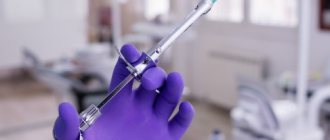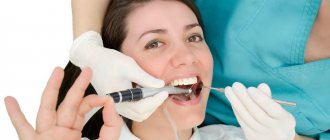- The first thing the gynecologist pays attention to during an external examination is the swelling of the genital organs. During pregnancy, due to increased blood circulation, the labia minora and majora lose their elasticity and become dense.
- The second sign of pregnancy is a change in the color of the internal genital organs. The vaginal walls take on a dark red or purple hue. The mucus released from the cervical canal becomes viscous and transparent.
- Then the doctor examines the cervix, appendages - fallopian or fallopian tubes, ovaries. During pregnancy, these organs enlarge and change their shape, so by palpation (manual examination) pregnancy is easy to determine.
- Next, the condition of the posterior vaginal vault is checked. Before pregnancy, the posterior vaginal vault has the shape of a retracted vault, and with the onset of pregnancy it becomes smooth.
Even during pregnancy, changes occur in a woman’s mammary glands.
Under the influence of hormones, the breasts begin to prepare for lactation (the process of feeding a child), more milk ducts are formed in it and the breasts increase in size. You should know that during an examination, a gynecologist can determine pregnancy, which is at least the fifth week, and to determine the onset of pregnancy earlier, an ultrasound examination (ultrasound) should be performed.
37th week of pregnancy for baby
At the 37th week of pregnancy, the baby’s height is approximately 48 cm, and his weight is 2,600 g. Externally, the fetus is almost no different from a newborn; all facial features are developed, and cartilaginous tissue is clearly visible. The accumulation of subcutaneous fat at this stage of pregnancy makes the body contours softer and rounder. The baby’s skin gradually smoothes out, it is no longer as pink as in the previous weeks of intrauterine development, and the integument gradually becomes lighter. The baby's body is still abundantly covered with lubricant, but the amount of vellus hair decreases noticeably, vellus hair remains only on the shoulders and back, and in some babies it disappears almost completely.
This week the accumulation of fatty tissue continues. It reaches a maximum of 15% of the child’s total body weight. It is difficult to overestimate the importance of adipose tissue for newborns; it is this tissue that protects the child from overheating or hypothermia, since the baby’s thermoregulation system after birth is not yet sufficiently formed and continues to develop in the first months of the little person’s life.
At this stage, not only the volume of subcutaneous fat increases, but also the muscles and skeleton intensively develop. The child constantly moves his arms and legs. These unique workouts help increase muscle mass. The baby also makes rhythmic breathing movements that strengthen the intercostal muscles and diaphragm, preparing the respiratory organs for childbirth.
Antibacterial therapy
If the disease is advanced and cannot be treated sparingly with the use of bactericidal ointments and solutions, then the doctor decides to use antibacterial drugs. The treatment regimen is determined individually, taking into account the duration of pregnancy, the stage of progression of bartholinitis, the presence of associated complications, and the type of pathogen that provoked the inflammation.
To destroy a bacterial infection, the following drugs are often prescribed:
- "Amoxiclav";
- "Augumentin".
The course of therapy and dosage are individual. Also safe for the fetus are drugs belonging to the group of cephalosporins:
- "Ceftriaxone" in the form of injections;
- "Cefexin" for oral administration.
If inflammation of the Bartholin glands occurs with complications, the pregnant woman is prescribed the antibiotic Sumamed. The course of therapy is carried out under the strict supervision of a specialist. The doctor monitors the condition of the unborn child, as well as the effectiveness of the drug used, and adjusts the regimen if necessary.
Pregnant woman at 37 weeks
As the due date approaches, pregnant women begin to notice the appearance of their precursors, that is, certain signs and changes that occur under the influence of hormones. A woman’s body is preparing to give birth to a child, progesterone gives way to the dominant role of the birth hormone estrogen, and the pregnant woman’s well-being changes.
From the 37th week, expectant mothers may observe the following changes:
- slight loss of body weight;
- reduction in abdominal volume;
- the appearance of training or “false” contractions and an increase in their intensity;
- discharge of mucus from the cervix.
The nature of the stool changes, it becomes weaker, aching pain in the lower back of varying intensity may appear, and the fundus of the uterus descends. The woman notes some signs on her own, others are observed by the gynecologist during a routine examination.
Precursors do not appear in all women. Some expectant mothers notice only some of the symptoms listed above, while others observe signs of impending labor not two or three weeks before the due date, but just a few hours. Both the appearance of precursors at the 37th week and their absence are normal and depend on the individual characteristics of the woman’s body.
This week, the female body is intensively preparing for the birth of a child. If the fetus is positioned correctly, head down, it gradually lowers, goes to the lower part of the uterus, presses it to the body and bends its limbs, intuitively taking the most comfortable position for passing the birth canal. The consequence of fetal movement is prolapse of the uterine fundus. The abdomen lowers, the pressure on the diaphragm decreases significantly, the pregnant woman can breathe easily, and the shortness of breath that plagued her in the previous weeks disappears. The pressure on the stomach also decreases, heartburn, a feeling of heaviness after eating and other unpleasant sensations disappear. Moving your baby can put pressure on your bowels and bladder. A pregnant woman at this stage often experiences the urge to urinate and may suffer from frequent loose stools. The reason for frequent bowel movements is not only the mechanical effect of the uterus on it, but also an increase in the content of estrogen in the body, hormones that promote the excretion of fluid. At the 37th week, the expectant mother can have bowel movements up to 3-4 times a day and at the same time observe significant dilution of the stool.
Recommendations before the lip contouring procedure
It is better to start preparing before the procedure. The further speed of healing largely depends on this. First of all, you need to make sure there are no contraindications. You can clarify their list during the initial consultation. You should pay attention to the presence of damage in the area of upcoming injections, as well as the presence of herpes. It is recommended to refuse the procedure in case of exacerbation of chronic diseases, infections, etc. Particular attention should be paid to the presence of herpes.
After examining and consulting the patient, the doctor may prescribe antiviral drugs. This is due to the fact that intervention can provoke a recurrence of infections. But starting to take them on your own without first consulting a specialist is highly discouraged. Additionally, before the procedure you should not take blood thinners. They increase the likelihood of bleeding.
The method cannot be used during pregnancy or breastfeeding. Additionally, drinking alcohol before lip augmentation is prohibited. This increases the likelihood of swelling and bruising. Sports activities and visiting the solarium are also prohibited. If you follow the recommendations correctly, you can significantly reduce the risk of complications.
38th week of pregnancy: development of the unborn baby
At the 38th week, the fetus is fully formed, so childbirth at this stage is no longer dangerous for both mother and baby. The weight of the fetus is about 3 kg, but this figure can vary significantly between babies; the weight depends on the individual characteristics of the mother and child, body structure and other factors. The body length of a newborn is approximately 50 cm.
All organs and systems at a period of 38 weeks are characterized by physiological and morphological maturity, they are completely ready for work. At this stage, the baby is preparing for childbirth, making breathing movements and preparing the intercostal muscles for breathing. The lung tissues are washed with amniotic fluid, which helps maintain the required level of surfactant covering the baby's lungs from the inside. All elements of the respiratory system are ready for use. With the first breath after birth, the alveoli begin to transfer oxygen from the air into the blood, gas exchange occurs, and the respiratory and circulatory systems begin to work intensively.
Immediately after the procedure
In fact, the entire healing procedure can be divided into several stages. Initially, swelling appears. Then hematomas may occur. This reaction is considered normal. Additionally, there may be a feeling of tightness and fullness in the mouth area.
You should not evaluate the result immediately after the procedure. It will change somewhat in the future. To understand what your lips will look like, you need to wait a few days. In general, the result is visible within a week.
If bruises appear, there is also no need to panic. They occur if the cosmetologist touches a vessel. The situation is not dangerous. However, this may not look aesthetically pleasing. They will go away on their own within a few days.
On the first day after the procedure, you should not drink hot drinks. It is better to minimize the use of cosmetics. Additionally, you should not swim in the pool or overheat. If you follow your doctor's recommendations, the likelihood of developing side effects is minimal.
Pregnant woman
The body of a pregnant woman continues to actively prepare for the birth of a baby, the content of estrogen rapidly increases, and the level of progesterone decreases significantly. Changes in hormonal levels help soften the tissues of the birth canal and cervix. Throughout pregnancy, the lumen of the cervical canal is closed by a plug of thick mucus, which protects the baby from infection, and the uterine cavity protects against the penetration of microorganisms hazardous to health. In the last weeks of pregnancy, the consistency of the mucus changes, it becomes more liquid and begins to gradually flow out. In some women, the mucus disappears gradually, while in other women in labor it comes off simultaneously. The discharge resembles colorless egg white in its consistency and appearance. Sometimes the mucus is pinkish, brown or yellow. The removal of the plug is painless; the woman may experience a slight feeling of discomfort in the lower abdomen. The removal of the plug may be signaled by more abundant vaginal discharge than during the entire pregnancy.
A woman should carefully monitor the color and volume of discharge, since too much colorless discharge may indicate not only the passage of the plug, but also be one of the symptoms of leakage of amniotic fluid. Indicator pads and amniotests or test strips will help determine the cause of the discharge. The pads are sold in many pharmacies and can be easily used at home. If leakage of amniotic fluid is confirmed, you should immediately consult a doctor.
After the mucus plug comes off, you should avoid visiting the pool and swimming in open water, as the risk of infection for the child increases significantly. It is also necessary to exclude sexual contact.
Dear men, loving husbands!
Remember that your pregnant wife is an “unusual” person the entire time she is carrying your child. That is why a loving husband should not allow his wife to overwork herself with housework. A pregnant woman needs to create favorable conditions so that she can safely bear and give birth to a child, i.e. so that her body can qualitatively adapt to changing conditions as the pregnancy progresses (the baby grows, develops, eats, “breathes,” etc. - conditions are constantly changing).
If a pregnant woman’s body cannot adapt normally, then she will experience various unfavorable conditions, primarily for the child. For a woman, these are also unfavorable conditions. In especially severe cases, pregnancy is sacrificed to save the woman, because... terminating a pregnancy in this condition immediately leads to recovery (conditionally to recovery), but your child will no longer be born.
Always take care of women! And especially during pregnancy!
39th week of pregnancy: what happens to the fetus?
At the 39th week, the child’s weight reaches 3,100-3,500 g, and his height is 50-52 cm. Height and weight indicators are very relative and can differ significantly. The baby is rapidly preparing for the most important test in his life - birth, which requires endurance and significant effort. During this period of pregnancy, the size and weight of the child’s adrenal glands, that is, the glands of the endocrine system, which are responsible for the human body’s response to stress factors, increase. It is the hormones adrenaline and norepinephrine produced by the adrenal glands that help the child adapt as quickly as possible to new temperature conditions, tactile, sound and light impulses.
All the baby's senses are developed at 39 weeks. Within a few moments after birth, the baby can focus his gaze, he reacts to bright light and moving objects, many scientists claim that newborns distinguish colors and see the faces of parents and doctors. In the last weeks of intrauterine life, the baby's hearing is also fully developed; after birth, he reacts to loud sounds and noise. A newborn baby can identify the basic shades of taste, recognize sour, bitter, sweet and salty.
In the womb, the baby is in an aquatic environment that minimizes contact. Immediately after birth, the baby experiences many tactile sensations; unlike intrauterine life, he feels the touch of his mother’s hands and diapers, towels, dressings and other materials. Babies especially like the touch of skin to skin, so in a modern maternity hospital, newborns are always placed on their mother’s stomach even before the umbilical cord is cut. The child adapts more easily to the new environment and feels protected. Placing the baby out has not only a psychological aspect, since it promotes the colonization of microorganisms from the mother’s skin onto the skin and mucous membranes of the baby, and increases his immunity.
Lip massage after augmentation
It is strictly not recommended to massage your lips immediately after the procedure. This is fraught with infection. You must wait at least a day. It is better to slightly increase this period. However, in general, massage is beneficial. It will help the drug to be evenly distributed on the lips. As a result, the risk of unevenness will be significantly reduced. Additionally, this effect helps restore blood circulation. Overall, it will be possible to significantly shorten the healing period. It is better to massage after the swelling subsides. Until this moment, there is an active recovery period, and massage can cause harm.
Pregnant woman
In the last weeks of pregnancy, the expectant mother strives to prepare her apartment or house as much as possible for the arrival of a new family member. Scientists call this sign of impending birth nesting syndrome. Many women observe signs of the syndrome from the thirtieth week of pregnancy, but at the 39-40th week nesting reaches its maximum point. Pregnant women strive to do general cleaning and repairs, re-stick wallpaper and purchase many new things that, in their opinion, are simply necessary in the house. After giving birth, many purchases cause confusion. The reason for this behavior is an increase in the level of adrenaline and norepinephrine in the body. These hormones are produced by the adrenal glands; they are necessary not only for the woman, but also for the baby to prepare for the upcoming birth.
40th week of pregnancy: how is the baby developing?
40 weeks – full-term pregnancy. The weight of a child born at this period ranges from 2,600 g to 4,400 g, and his body length is 48-53 cm. These indicators are very arbitrary, since at 40 weeks miniature babies weighing 2,600 g and real heroes are born, whose body weight approaches 5,000 g. The body length of newborns can also vary from 45 to 55 cm.
Most women give birth at 40 weeks. At this stage, the baby is completely ready for birth; it meets all the parameters of a full-term baby. Before birth, the baby presses its arms and legs closely to the body, bends its head as much as possible and presses against the exit of the uterus. This position makes it possible to pass the birth canal with the narrowest part of the skull. During labor, with each contraction, the child gradually moves downward; he does not move in a straight line, but makes helical-translational movements, as if screwing into the mother’s birth canal. As the newborn moves forward and his head descends completely, the cervix opens completely. This is followed by pushing, that is, contractions of the uterus that move the baby along the birth canal. The baby's head gradually appears, followed by his body. Childbirth is a complex mechanism that is aimed not only at the safe passage of the birth canal by the child, protecting him from accidental injuries due to increased pressure, but also at preventing ruptures of the woman’s soft tissues.
Detection of cervical diseases
To determine the presence or absence of pathological changes, the doctor conducts a screening examination of the cervix, including:
- cytological examination - analysis of particles of the epithelium of the cervix and cervical canal for the presence of atypical cells, including cancer cells;
- microflora smear - analysis of vaginal or cervical mucus for the ratio of beneficial, opportunistic and pathogenic microorganisms, indicating the general condition of the body, the reproductive system, the presence or absence of inflammatory diseases;
- smear for infection - examination of the mucous discharge from the vagina for the presence of clearly pathogenic microorganisms (viruses, bacteria, fungi, protozoa), indicating the presence of an infectious process in the genital tract.
Also, as part of a screening study, hystroscopy may be prescribed - a visual examination of the cervix using a thin and flexible instrument equipped with a camera or optical system (hystroscope). It is inserted directly into the vagina and cervical canal, allows you to evaluate the color and thickness of their mucous membranes, determine the presence of polyps and other neoplasms, the size of the cervical lumen, etc.
The combination of these methods gives doctors the opportunity to determine the general condition of a woman’s body and her reproductive system, and promptly identify possible pathologies and complications. This increases the likelihood of their successful treatment, including gentle conservative methods.
Pregnant woman
The long wait to meet your unborn child is coming to an end; the 40th week of pregnancy is the last for most women. Every day the expectant mother’s anxiety increases, and the long wait affects her mood and well-being. Women strive to give birth to a child as quickly as possible, so that pregnancy and painful contractions become a thing of the past. Every pregnant woman dreams of meeting her baby, wants to hold him to her breast and stroke his tender head.
Many women, especially first-time mothers, worry that labor will begin unnoticed, but such cases are extremely rare. A woman feels the onset of labor, feels regular contractions that repeat at certain intervals and gradually increase, the time interval between them shortens.
Contractions may be preceded by prenatal rupture of amniotic fluid, which is observed in a certain percentage of women in labor. After the water breaks, contractions may be quite weak or completely absent. Regardless of the intensity of contractions, the release of water is one of the signs of the onset of labor and requires immediate contact with specialists and the woman’s hospitalization in a maternity hospital or hospital, since when the water breaks, the integrity of the bladder is disrupted and the risk of microorganisms dangerous to the baby’s health entering the uterine cavity increases. It is important that after the water breaks, the baby is born within a maximum of 10-12 hours.
A pregnant woman must properly tune in to childbirth, concentrate on the desired result and believe in her own strength, and complete the task intended for her by nature. The right psychological attitude and theoretical knowledge will help a woman become a mother, successfully go through all stages of childbirth and hold the long-awaited child to her heart.
Function of the gastrointestinal tract
There are changes in the function of the gastrointestinal tract. A number of women experience a perversion of taste sensations such as aversion to certain types of food (meat, fats), the appearance of taste whims (the desire to eat even clay, chalk), an increase in appetite, and in some cases its decrease. Due to a decrease in gastric secretion, the evacuation ability of the stomach slows down. Intestinal function in pregnant women is characterized by decreased tone and decreased intestinal motility, which determines the tendency to bloating, constipation, and hemorrhoids.
Metabolism
Characterized by an increase in metabolic processes.
- Basal metabolism and oxygen consumption increase, especially in the second half of pregnancy and childbirth.
- Changes in water-electrolyte metabolism are characterized by fluids.
- Carbohydrate metabolism is characterized by an increase in glucose in the blood, and when the body is overloaded with carbohydrates, it appears in the urine (glucosuria). During pregnancy, latent forms of diabetes mellitus appear.
- The content of fats and cholesterol in the blood increases, but no pathological manifestation of this condition is observed. There is increased fat deposition with a characteristic distribution in the subcutaneous tissue, mammary glands, lower abdomen, thighs, and buttocks. Fats are used to build the tissues of the body of the mother and fetus, and are also energy material.
- During pregnancy, there is an increased need for vitamins (A, B, D, C, E, K, PP).
- In some women, due to pregnancy, sweating increases and the discharge of liquid salts from the vagina, which are a mixture of mucus and transudate of the vasculature of the genital organs, increases.
The variety of external and internal changes in a woman’s body increases with increasing pregnancy, are characteristic only of the state of pregnancy and are aimed at creating optimal conditions for the development of the fetus and the course of labor.
That is why the norms characteristic of non-pregnant women cannot be transferred to pregnant women.
The norm of pregnancy is considered to be the average statistical indicators of functional tests characteristic of uncomplicated development of pregnancy.
Each trimester of pregnancy has its own norms. Knowledge of the norms allows you to avoid unreasonable actions that can cause a violation of the physiological balance established between the fetus and the mother’s body.










